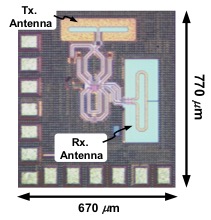Afshari group receives Best Invited Paper award at the 2019 IEEE Custom Integrated Circuits Conference
Terahertz and sub-terahertz imaging can provide superior results in some biomedical imaging, spectroscopy, and water saturation detection.
Prof. Ehsan Afshari and his group received the Best Invited Paper Award at the 2019 IEEE Custom Integrated Circuits Conference for providing an overview of the state-of-the-art in terahertz imaging.
Advances in the area of high-speed electronics during the last decade have opened the door to the practical use of high frequency sub-terahertz and terahertz (0.3THz-3THz) waves. THz waves are much safer for biomedical imaging compared to options such as X-ray, they can detect easily water content, and they can be used for high resolution imaging applications such as spectroscopy, ie, detection of a given material based on its spectral fingerprint. THz waves are also appealing for high data rate communication systems.
Afshari works in what is called teraherz gap (typically considered 0.1 – 1 THZ). This frequency is higher than typically ideal for standard electronics, yet lower than suitable for optical processes.
“Even below one terahertz,” said Afshari, “there are a lot of competing technologies. One of the main advantages, and challenges, of what we do is building the system on standard CMOS technology – it’s very low cost and results in a very effective system.”

 Enlarge
Enlarge
Afshari builds devices that are very small – less than a millimeter. His integrated systems are able to add significant functionality, such as signal processing, right on the chip, and his chips can be combined into an array. These arrays can do beamforming, which means an image can be captured in 3D from a single vantage point, saving the need to move either the device or the object.
Currently, with a single chip, his devices can image from a distance of about 5 meters. With a larger array and the addition of external antennas or lenses, that distance could extend to 10s or even 100s of meters. His devices can penetrate clothing as well as the surface of human skin.
Afshari’s fully integrated frequency-modulated continuous-wave (FMCW) radar shown in figure 1 demonstrated the possibility of SAR/Inverse SAR (ISAR) imaging to achieve a fine resolution with a fully integrated THz radar.

 Enlarge
Enlarge
As shown in Figure 2, his group was able to detect a metallic blade and plastic ring (pictured right) from inside a wallet (left) at a resolution of 1cm x 1cm. This technology can also be used to detect dangerous explosives, or tumors just beneath the skin.

 Enlarge
Enlarge
Afshari’s devices are also able to detect the level of moisture in objects and in biological tissue. Figure 3 shows 2D and 3D ISAR imaging of a piece of meat, where the fat was clearly distinguished from muscle.
Details of these and additional imaging systems are described in the award-winning paper, Fully Integrated Solutions for High Resolution Terahertz Imaging, authored by former students Ali Mostajeran (PHD 2018); now at Lyft), Hamidreza Aghasi, (PHD 2017; now at UC-Irvine), current U-M doctoral student S.M. Hossein Naghavi, and Professor Ehsan Afshari.
 MENU
MENU 
